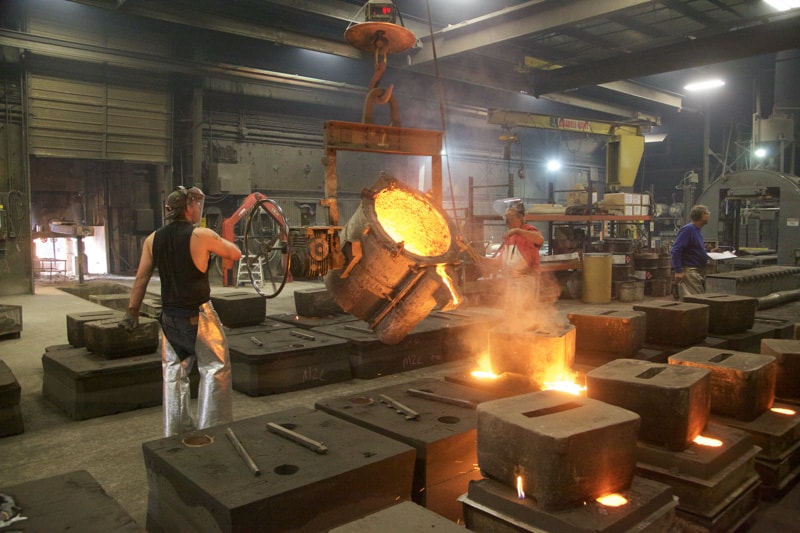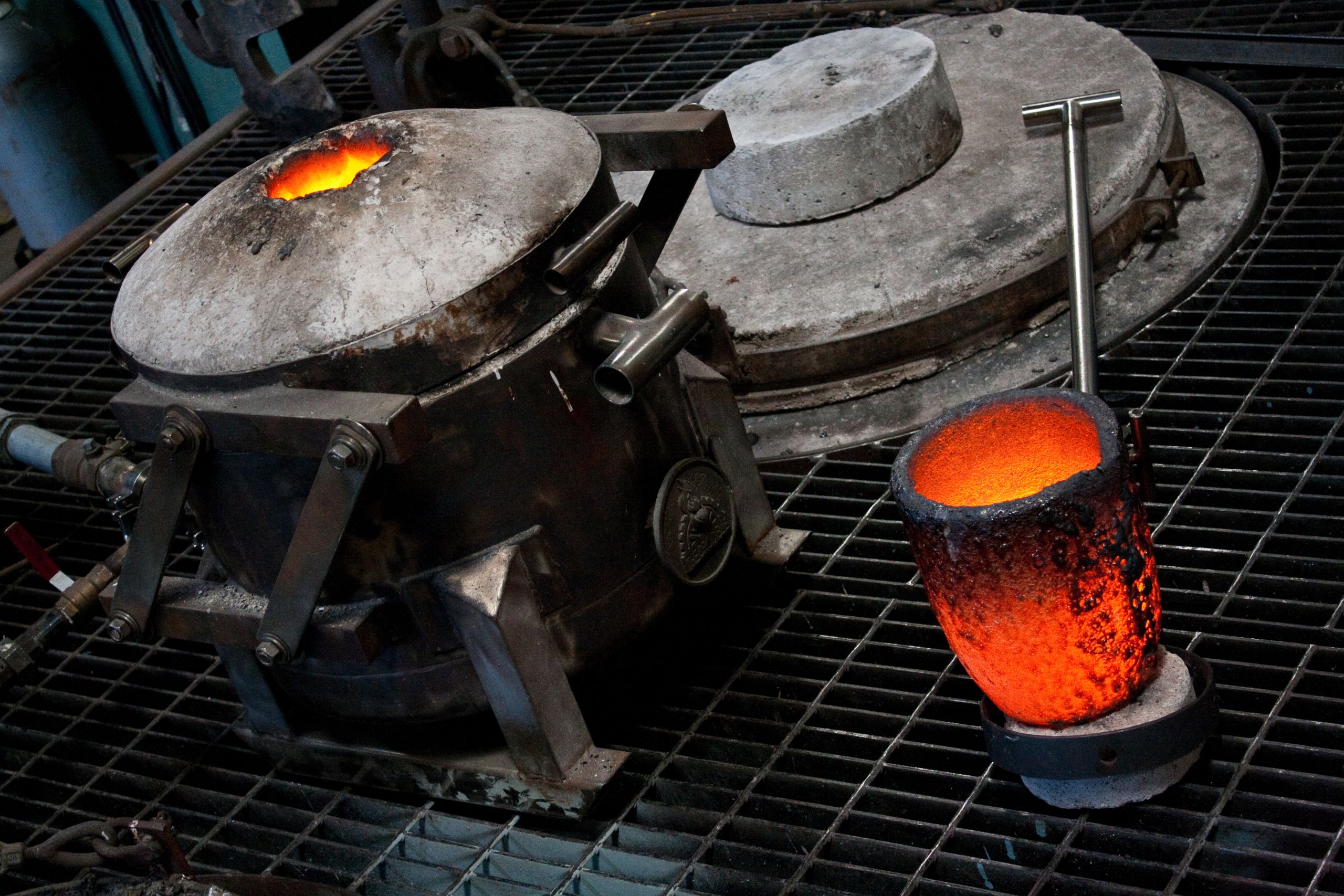Casting Foundry Worker Safety Manual: Top Rules for Staff and Supervisors
Exploring the Important Role of Casting Foundry in Modern Manufacturing
Casting shops are essential in contemporary manufacturing, providing crucial parts across diverse sectors. Casting Foundry. Their capability to generate detailed, lightweight parts fulfills the expanding demands for effectiveness and quality. The landscape is progressing, influenced by technical advancements and sustainability problems. As these factories browse possibilities and challenges, their future duty in manufacturing continues to be unsure. What techniques will they employ to adapt and prosper in this vibrant atmosphere?
The Basics of Casting: Comprehending the Refine
Spreading has been an essential production process for centuries, its concepts continue to be vital to contemporary market. This procedure involves putting a liquid material, generally steel, right into a mold and mildew to create a certain form. The mold and mildew is designed to develop the wanted end item, which solidifies as it cools. Key stages in casting consist of pattern production, mold and mildew creation, pouring, and completing. Each phase requires careful attention to information, ensuring that the end product fulfills quality and dimensional requirements.
The flexibility of Casting allows for the manufacturing of complex geometries that would certainly be difficult or difficult to attain through other making approaches. Additionally, Casting can fit a selection of products, consisting of metals and polymers. This versatility makes it an important strategy for industries ranging from vehicle to aerospace, sustaining advancement and performance in the production of elements that fulfill the demands of contemporary applications.
Sorts Of Casting Techniques and Their Applications
Casting strategies are diverse, each tailored for certain applications and product requirements. Sand Casting is among the oldest methods, ideal for complex geometries and huge parts, utilizing sand mold and mildews. Financial investment spreading, understood for its precision, is optimal for complex styles and is commonly made use of in aerospace and clinical industries. Pass away casting, typically employed for high-volume manufacturing, enables for rapid production of smaller get rid of great surface coating, typically in light weight aluminum or zinc alloys. Shell Casting provides a balance between the two, supplying great information and good toughness, making it preferred in automotive applications. Permanent mold and mildew casting, used for non-ferrous steels, delivers a tighter dimensional tolerance and far better mechanical properties. Lastly, centrifugal Casting works for creating cylindrical parts, frequently discovered in pipelines and tubes - Casting Foundry. Each technique offers unique objectives, underscoring the versatility and importance of Casting in modern production
The Influence of Casting Foundries on Market Advancement
As sectors endeavor for better efficiency and product high quality, the duty of casting shops becomes progressively essential in driving technology. These facilities function as the foundation for generating complex elements across numerous fields, including automotive, aerospace, and energy. By leveraging advanced Casting methods and materials, factories add to the growth of lighter, more powerful, and more long lasting products that meet advancing consumer demands.

In addition, factories promote the use of lasting practices, such as reusing metal and decreasing waste, which aligns with modern-day market criteria for environmental duty. Eventually, the innovative capabilities of casting shops not only enhance manufacturing effectiveness yet also push whole industries into a future identified by technical development and sustainability.

Obstacles Facing Casting Foundries in a Modern Economy
While development continues to improve the manufacturing landscape, casting foundries deal with a myriad of challenges that threaten their operational stability. One significant concern is the boosting competition from sophisticated production innovations, such as additive production, which can create complicated components with much less material waste. Additionally, the varying rates of basic materials, especially metals, present financial dangers, influencing price predictability. Labor shortages additionally worsen these obstacles, as skilled employees end up being harder to maintain and find in the middle of an aging labor force. Furthermore, governing stress concerning emissions and office safety and security need shops to buy expensive upgrades, usually stressing restricted sources. The need for digital transformation likewise looms big, as many factories battle to embrace Industry 4.0 innovations that boost efficiency and data administration. Jointly, these difficulties urge casting foundries to adapt promptly or take the chance of obsolescence in a progressively open market.
Sustainability Practices in Casting Foundries
Among the challenges facing Casting foundries, the helpful resources adoption of sustainability practices has actually become a crucial method for boosting functional resilience and competitiveness. Foundries are progressively concentrating on minimizing waste via reliable source management, recycling scrap metal, and using environmentally friendly materials in their procedures. The implementation of energy-efficient modern technologies is one more crucial aspect, as it aids lower energy usage and carbon emissions.
Additionally, numerous foundries are taking on closed-loop systems to lessen water use and reduce the environmental impact of operations. Employee training in sustainable techniques cultivates a society of ecological obligation, making certain that all team members are participated in sustainability campaigns.
Integrating Technology in Casting Processes
Incorporating innovative modern technologies right into casting processes has actually ended up being a critical variable in driving effectiveness and advancement within shops. Automation and robotics are progressively utilized to simplify manufacturing, decreasing labor prices and lessening human error. Advanced software for simulation and modeling enables designers to forecast results and enhance layouts before physical production starts. In addition, the consolidation of 3D printing technology greatly boosts the prototyping phase, facilitating rapid growth and lowering preparations.
Furthermore, real-time tracking systems making use of IoT gadgets allow factories to track efficiency metrics and determine potential problems early in the Casting procedure. This data-driven technique not only improves quality assurance but additionally supports upkeep methods that prevent pricey downtimes. Therefore, integrating these modern technologies fosters a more dexterous manufacturing atmosphere, enabling foundries to respond swiftly to market needs while preserving high requirements of high quality and sustainability.
The Future of Casting Foundries in Production

Additionally, the need for high-performance and light-weight materials in fields like aerospace and vehicle will drive innovation within shops. Partnerships between shops and manufacturers will likely raise, promoting a much more incorporated supply chain that emphasizes fast prototyping and customization. As digital makeover proceeds, foundries may likewise leverage data analytics to maximize operations from this source and anticipate upkeep requirements, making certain competitiveness. Eventually, the future of casting foundries hinges on their capacity to adapt to technological innovations and market demands while maintaining quality and cost-effectiveness.
Often Asked Inquiries
What Materials Are Frequently Used in Casting Foundries?
The materials frequently made use of in casting foundries include steels such as light weight aluminum, steel, iron, and bronze, along with different alloys. Additionally, sand, resin, and ceramic are typically used for mold and mildews and core manufacturing.
Exactly How Do Casting Foundries Ensure Quality Assurance in Manufacturing?
Casting foundries execute extensive quality assurance actions, including normal examinations, standard screening, and adherence to market qualifications. These methods ensure that each product meets specified tolerances and performance standards, thereby maintaining high levels of reliability and consumer satisfaction.
What Are the Security Steps in Casting Foundries?
Safety and security procedures in casting foundries consist of using personal protective tools, correct ventilation systems, regular tools maintenance, employee training programs, and adherence to security policies to minimize threats related to liquified metal handling and machinery procedure.
The length of time Does the Casting Process Normally Take?
The Casting process normally takes numerous hours to numerous days, depending on variables such as the intricacy of the design, the products made use of, and the cooling time required for the actors components to solidify effectively.
What Is the Role of Designers in Casting Foundries?
Engineers in casting factories oversee layout, process optimization, and high quality control. They assure that materials fulfill specs, troubleshoot manufacturing issues, and carry out cutting-edge strategies, ultimately adding to performance and the successful fabrication of steel components.
Casting foundries are essential in modern manufacturing, providing vital components across diverse markets. While innovation continues to reshape the production landscape, casting factories encounter a myriad of challenges that threaten their operational feasibility. In the middle of the obstacles confronting Casting foundries, the adoption of sustainability practices has emerged as an essential technique for boosting operational durability and competition. In enhancement, click to read more real-time surveillance systems making use of IoT gadgets enable foundries to track performance metrics and identify potential issues early in the Casting procedure. The products generally made use of in casting shops include metals such as aluminum, bronze, iron, and steel, along with numerous alloys.